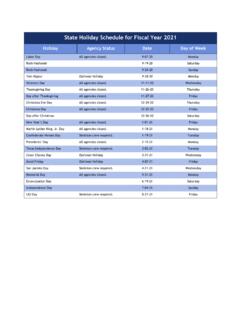Transcription of Federal Holidays: Evolution and Current Practices
1 Federal Holidays: Evolution and Current Practices Updated July 1, 2021 Congressional Research Service R41990 Federal Holidays: Evolution and Current Practices Congressional Research Service Summary The United States has established by law the following 12 permanent Federal holidays, listed in the order they appear in the calendar: New Year s Day, Martin Luther King Jr. s Birthday, Inauguration Day (every four years following a presidential election), George Washington s Birthday, memorial Day, Juneteenth National Independence Day, Independence Day, Labor Day, Columbus Day, Veterans Day, Thanksgiving Day, and Christmas Day. Although frequently called public or national holidays, these celebrations are only legally applicable to Federal employees and the District of Columbia, as the states individually decide their own legal holidays. The first four congressionally designated Federal holidays were created in 1870, when Congress granted paid time off to Federal workers in the District of Columbia for New Year s Day, Independence Day, Thanksgiving Day, and Christmas Day.
2 In 1880, George Washington s Birthday was included. In 1885, Congress extended holiday coverage for some holidays to all Federal employees. Although Thanksgiving Day was included in the first holiday bill of 1870, it was not until 1941 that Congress specifically designated the fourth Thursday of November as the official date. Since 1888, Congress has added seven Federal holidays, creating Decoration Day (now memorial Day) in 1888, Labor Day in 1894, Armistice Day (now Veterans Day) in 1938, Inauguration Day in 1957 (quadrennially and only celebrated in the District of Columbia), Columbus Day in 1968, Martin Luther King Jr. s Birthday in 1983, and Juneteenth in 2021. In 1954, Armistice Day was broadened to honor Americans who fought in World War II and the Korean conflict, and the name of the holiday was changed to Veterans Day. In 1968, the Uniform Monday Holiday Act was enacted to provide for uniform annual observances of Washington s Birthday, memorial Day, and Veterans Day.
3 Additionally, the Monday Holiday Law established Columbus Day to be celebrated on the second Monday in October. In 1975, Veterans Day celebrations were returned to November 11 by Congress. Federal Holidays: Evolution and Current Practices Congressional Research Service Contents Creation of Federal Holidays .. 1 New Year s Day, Independence Day, Thanksgiving Day, and Christmas Day .. 1 Washington s Birthday .. 2 Decoration Day/ memorial Day .. 2 Labor Day .. 3 Armistice Day/Veterans Day .. 3 Thanksgiving Day .. 4 Inauguration 5 Columbus Day .. 6 Birthday of Martin Luther King, Jr.. 6 Juneteenth National Independence Day .. 7 Uniform Monday Holiday Act .. 8 Federal Holidays and Employee Pay .. 8 Recent Holiday 10 Contacts Author Information .. 11 Federal Holidays: Evolution and Current Practices Congressional Research Service 1 ince 1870, numerous proposals have been introduced in Congress to establish permanent Federal holidays.
4 Twelve have become Although these patriotic celebrations are frequently referred to as national holidays, legally they are only applicable to Federal employees and the District of Columbia. Neither Congress nor the President has asserted the authority to declare a national holiday that would be binding on the 50 states, as each state individually determines its legal holidays. Creating a holiday for Federal employees does affect each state in a variety of ways, including the delivery of mail and conduct of business with Federal agencies. Federal holidays have been created for a number of reasons. In several instances, Congress created Federal holidays after a sizeable number of states created state holidays. In other instances, Congress took the lead. Additionally, each holiday was designed to emphasize a particular aspect of American heritage or to celebrate an event in American history.
5 Creation of Federal Holidays In 1870, when Congress passed the first Federal holiday law, the Federal government employed approximately 5,300 workers in Washington, DC, and another approximately 50,600 around the The distinction between Federal employees working in the District of Columbia and those elsewhere proved important because the initial holiday act only applied to the Federal workforce in Washington, DC. Federal employees in other parts of the country did not receive holiday benefits until at least 1885, as Federal holidays were initially interpreted as only applying to Federal workers in the District of For more information on applicability of Federal holidays to Federal employees, see Federal Holidays and Employee Pay below. New Year s Day, Independence Day, Thanksgiving Day, and Christmas Day On June 28, 1870, the first Federal holidays were established for Federal employees in the District of Apparently drafted in response to a memorial drafted by local bankers and business men, the June 28 act provided that New Year s Day, Independence Day, Christmas Day, and any day appointed or recommended by the President of the United States as a day of public fasting or thanksgiving [were] to be holidays within the District [of Columbia].
6 5 This legislation 1 5 6103. 2 Rep. Fernando Wood, Finance, remarks in the House Congressional Record, vol. 2, part 3 (March 7, 1874), p. 2053. 3 23 St at . 516, January 6, 1885. T he act of January 6, 1885, specifically aut horized pay for all Federal employees on Federal holidays. The statute read, That employees of the Navy Yard, Government Printing Office, Bureau of Printing and Engraving, and all ot her per diem employees of t he Government on dut y at Washingt on, or elsewhere in the United States, shall be allowed t he following holidays, t o wit : T he first day of January, t he t went y-second day of February, t he fourt h day of July, t he t went y-fift h day of December, and such days as may be designat ed by t he P resident as days for national thanksgiving, and shall receive the same pay as on other days.
7 (emphasis added). 4 20 St at . 277, January 31, 1879. 5 16 St at . 168, June 28, 1870. S Federal Holidays: Evolution and Current Practices Congressional Research Service 2 was drafted to correspond with similar laws of States around the District, 6 and in every State of the Union. 7 Washington s Birthday In January 1879, Congress added George Washington s Birthday to the list of holidays observed in the District of Columbia. The principal intent of the law was to make February 22 a bank holiday. 8 In summarizing the bill, Representative Burton Cook explained Congress s intent in creating a bank holiday.. and for all purposes of presenting for payment or acceptance or the maturity and protect and giving notice of the dishonor of bills of exchange, bank checks, promissory notes, and other negotiable commercial paper shall be treated and considered as is the first day of the week, commonly called Sunday; and that all notes, drafts, checks, or other commercial or negotiable paper falling due or maturing on either of said holidays shall be deemed as having matured the day Enactment of the Uniform Monday Holiday Act10 in 1968 shifted the commemoration of Washington s Birthday from February 22 to the third Monday in February.
8 Contrary to popular belief, neither the Uniform Monday Holiday Act, nor any subsequent action by Congress or the President, mandated that the name of the holiday observed by Federal employees in February be changed from Washington s Birthday to Presidents Day. The Uniform Monday Holiday Act is examined in detail later in this report. Decoration Day/ memorial Day In 1888, Decoration Day (now memorial Day) became a holiday for Federal workers in the District of Decoration Day was likely created primarily because a sizable number of Federal employees were also members of the Grand Army of the Republic, an organization of Union Civil War veterans who desired to participate in memorial Day ceremonies honoring those who had died in the Their absence from work meant the loss of a day s wages. Some Members of Congress felt that Federal employees should be allowed this day as a holiday with pay, so that they might not suffer loss of wages by reason of joining in paying their respects to the memory of those who died in the service of their country.
9 13 6 Rep. Burton Cook, Holidays in the District, remarks in t he House, Congressional Globe, vol. 42, part 5 (June 17, 1870), p. 4529. 7 Sen. Hannibal Hamlin, Legal Holidays in the District, remarks in the Senate, Congressional Globe, vol. 42, part 6, (June 24, 1870), p. 4805. 8 Sen. Stephen Dorsey, February Twenty-Second, remarks in the Senate, Congressional Record, vol. 7, part 1 (February 12, 1878), p. 955. 9 Ibid. 10 P .L. 90-363, 82 St at . 250-251, June 28, 1968; 5 6103. 11 25 St at . 353, August 1, 1888. 12 Decorat ion Day, May 30, was widely observed in Nort hern st at es as a dat e for commemorat ion of t he Civil War dead and decoration of their graves. For more information, see Robert J. Myers, Celebrations: The Com plete Book of Am erican Holidays (Garden Cit y, NY: Doubleday & Company, 1792), pp. 159-164.
10 13 Rep. Henry Lovering, Pay for Decoration Day, remarks in the House, Congressional Record, vol. 17, part 7 (July 15, 1886), p. 6999. T he bill debat ed became law, but was only applicable t o per diem laborers in t he government [24 St at . 644, February 23, 1887]. Federal Holidays: Evolution and Current Practices Congressional Research Service 3 With the passage of the Uniform Monday Holiday Act in 1968,14 the observance of memorial Day was permanently changed from May 30 to the last Monday in May. Labor Day In 1894, Labor Day became a Federal Created to honor the country s labor, the holiday stood in contrast to previous Federal holidays designed to commemorate traditional celebrations ( , Christmas and New Year s), patriotic celebrations, war, or individuals. In its report on the legislation, the House Committee on Labor stated, [t]he use of national holidays is to emphasize some great event or principle in the minds of the people by giving them a day of rest and recreation, a day of enjoyment, in commemoration of it.


















